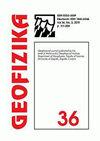Regional analysis of wind velocity patterns in complex terrain
IF 1.1
4区 地球科学
Q4 GEOCHEMISTRY & GEOPHYSICS
引用次数: 1
Abstract
Wind energy is a weather and climate-dependent energy resource with natural spatio-temporal variabilities at time scales ranging from fraction of seconds to seasons and years, while at spatial scales it is strongly affected by the terrain and vegetation. To optimize wind energy systems and maximize the energy extraction, wind measurements on various time scales as well as wind energy forecasts are required and needed. This study focuses on spatio-temporal characteristics of the wind velocity in complex terrain, relevant to wind energy assessment, operation, and grid integration, using data collected at 11 towers ranging from 40 to 80 m tall over a 12-year period in complex terrain of westerncentral and northern Nevada, USA. The autocorrelation analysis, Detrended Fluctuation Analysis (DFA) and Detrended Cross-Correlation Analysis (DCCA) showed strong coherence between the wind speed and direction with slowly decreasing amplitude of the multi-day periodicity with increasing lag periods. Besides pronounced diurnal periodicity at all locations, statistical analysis and DFA also showed significant seasonal and annual periodicities, long-memory persistence with similar characteristics at all sites and towers with a relatively narrow range of the Weibull parameters. The DCCA indicates similar wind patterns at each tower, and strong correlations between measurement sites in spite of separations of about 300 km across the towers’ setup. The northern Nevada area exhibits higher wind resource potential and higher wind persistence compared to the western-central region. Overall, the DFA and DCCA results suggest higher degree of complementarity among wind data at measurement sites compared to previous standard statistical analysis.复杂地形中风速模式的区域分析
风能是一种依赖于天气和气候的能源,在从几秒到季节和年份的时间尺度上具有自然的时空变化性,而在空间尺度上,它受到地形和植被的强烈影响。为了优化风能系统并最大限度地提高能量提取,需要各种时间尺度上的风力测量以及风能预测。本研究利用美国内华达州中西部和北部复杂地形中11座40至80米高的塔架在12年内收集的数据,重点研究了复杂地形中风速的时空特征,这些特征与风能评估、运营和电网整合有关,去趋势波动分析(DFA)和去趋势互相关分析(DCCA)表明,风速和风向之间具有较强的相干性,多日周期的振幅随着滞后期的增加而缓慢减小。除了在所有地点都有明显的日周期性外,统计分析和DFA还显示出显著的季节性和年周期性,在威布尔参数范围相对较窄的所有地点和塔架都具有相似特征的长记忆持久性。DCCA表明,每座塔的风型相似,尽管塔的设置间隔约300公里,但测量点之间的相关性很强。与中西部地区相比,内华达州北部地区表现出更高的风资源潜力和更高的风力持续性。总体而言,DFA和DCCA的结果表明,与之前的标准统计分析相比,测量点的风数据具有更高程度的互补性。
本文章由计算机程序翻译,如有差异,请以英文原文为准。
求助全文
约1分钟内获得全文
求助全文
来源期刊

Geofizika
地学-地球化学与地球物理
CiteScore
1.60
自引率
0.00%
发文量
17
审稿时长
>12 weeks
期刊介绍:
The Geofizika journal succeeds the Papers series (Radovi), which has been published since 1923 at the Geophysical Institute in Zagreb (current the Department of Geophysics, Faculty of Science, University of Zagreb).
Geofizika publishes contributions dealing with physics of the atmosphere, the sea and the Earth''s interior.
 求助内容:
求助内容: 应助结果提醒方式:
应助结果提醒方式:


